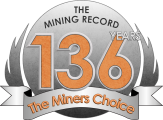Confirmation Of Mineralization Extends Hotspot Zone
Confirmation Of Mineralization Extends Hotspot Zone
VANCOUVER – Walker River Resources Corp. reported on the late 2022 reverse circulation (RC) drill program at the Lapon Gold Project located approximately 60 kilometers southeast of Yerington, Nevada. Drilling continues to confirm mineralization at Lapon Canyon and extend the Hotspot zone. At total of ten (10) holes were drilled here, including seven (7) at the new Hotspot zone, discovered during 2022.
RC Drill hole LC 22-92 returned 1.65 g/t Au over 97.6 meters at a depth of 24.4 meters including 26.95 g/t Au over 3 meters from a depth of 57.9 meters. RC Drill hole LC 22-94 returned 1.10 g/t Au over 73.2 meters at a depth of 32 meters. RC Drill hole LC 22-93 returned 1.25 g/t Au over 24.4 meters at a depth of 39.6 meters. RC Drill hole LC 22-91 returned 1.05 g/t Au over 35.5 meters at a depth of 27.4 meters.
The drilling has extended the Hotspot zone along strike (laterally), depth and width. Robust nature and continuity of the gold mineralized alteration zone is evidenced by the length of the drill intercepts at the Hotspot zone. The sub to horizontal nature of the Hotspot zone is confirmed by these recent drill results. Previously drilled holes LC 20-35 (1.35 g/t over 22.9 meters) and LC 21-67 located some 100 meters NW of the new Hotspot zone confirmed its discovery.
Drill holes showing lower anomalous gold mineralization (300-800ppb) are significant in indicating the presence of potential higher-grade mineralization nearby. The 2023 drill programs at Lapon Canyon will now consist of systematic drilling on section for geological modeling purposes, exploration drilling to discover new gold mineralization, extension of known gold mineralization, in several directions, including now at depth. This recent drill program demonstrated the feasibility of drilling multiple holes from the same drill pad set up, saving time and costs.
This present drilling has extended the strike length and width of the Hotspot zone. The intercepts are a minimum of 60 meters apart. Drill holes LC 22- 90 to LC 22-96 were completed from two drill pads, located some 40 meters above and 50 meters away from the Hotspot discovery drill pad (LC 21-80 to LC21-82). Results have also shown that the zone has migrated slightly to the SE. Three drill holes LC 22-87 to LC 22-89, were drilled at the far northern contact with the mineralized alteration zone, approximately 400 meters away from the Hotspot zone, located at the southern region of the mineralized zone. These holes were designed for geological reconnaissance purposes. Notwithstanding, significant anomalous gold values were encountered in granite here.
It is notable that historical workings are present approximately 100 meters above these holes. Hole LC 22-88 was lost at 30 meters. Hole LC 22-90 was lost 35 meters down but did return 0.89 g/t over 7 meters.
Drilling in 2023 will focus on extending strike, width and depth of the Hotspot zone. Drilling across the alteration zone between the area of Holes LC 22-87-89, the Hotspot zone, including, previous discoveries at Holes LC 19-42 and LC 19-43.
The gold mineralization at Lapon Canyon is contained in a wide (over 300 meters), long (over 4 km strike length) intensely altered (sericite, iron oxides) sheared and faulted NE trending fault zone. Gold mineralization is present pervasively throughout as an envelope of lower grade mineralization (0.5 to 2.0 g/t Au) enveloping distinct high-grade structures that have been drilled over a strike length of over 850 meters and a vertical extent of 400 meters. The high-grade gold mineralization is encountered in discrete, traceable zones located at the intersection of flat lying porphyry dikes and vertical stockwork chimneys.
The Company completed its initial RC drill program at the Pikes Peak portion of the Lapon Gold Project (located approximately 4 km north of Lapon Canyon). There are no previously reported drill holes, or any modern data available from the extensive historical mine working at Pikes Peaks. The initial RC drill program was designed for geological reconnaissance, to determine geological parameters and develop mineralization targets for the next drill program here in 2023. However, unexpected significant gold mineralization was encountered at the bottom of PP 22-01. This hole was planned to be drilled to the 300-meter level but was abandoned due to extensive fracturing and ground water at 107 meters. PP 22-01 returned 0.946 g/t Au over 10.6 meters from 96 to 107 meters. Most notably, the final 4.5 meters returned 1.5 g/t with the final assay at the bottom returning 1.93 g/t over 1.5 meters at 107 meters down. Finally, this interval was contained within unaltered granite, and may represent a major fault zone.




Comments (0)